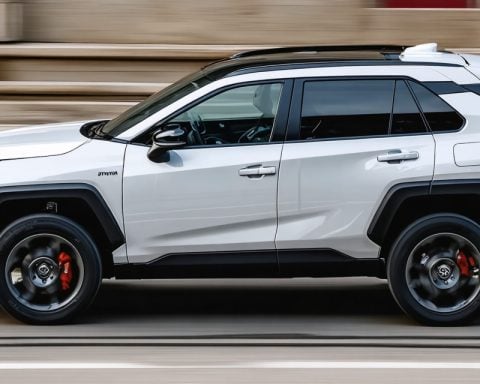The Electric Vehicle Market: A Bumpy Road Ahead
The electric vehicle (EV) market has seen its share of turbulence, with stocks like Rivian Automotive and Lucid Group experiencing drastic drops. Rivian’s stock price plummeted by an astonishing 79%, while Lucid suffered an even steeper 92% decline over three years. Despite this volatility, there is a flicker of hope: EV sales in the U.S. grew by 7%, totaling 1.3 million vehicles last year.
However, the future remains uncertain for these emerging companies. Lucid has dazzled car enthusiasts with its Air sedan, earning multiple accolades for its luxury and performance. Yet, financial struggles loom large, as reported revenues in the last quarter only reached $200 million, while losses surged to nearly $1 billion. The increase in vehicle deliveries offers some promise, yet production levels remain modest.
On the other hand, Rivian is overcoming its own obstacles. The company’s recent production fell by 13.5%, although deliveries increased slightly. Positive news includes reduced material costs and a commitment to achieving gross profit by the end of the fourth quarter. Rivian is also set to release more affordable vehicle models in the coming years, aiming to broaden its customer appeal.
In the grand scheme of things, Rivian may hold more promise than Lucid, thanks to its proactive management strategies and impending model releases. The journey ahead for both companies is fraught with challenges, yet the future of the EV market remains anything but dull.
The Future of Electric Vehicles: A Global Perspective
The electric vehicle (EV) market represents far more than just a transition in automotive technology; it serves as a crucial component in the global push toward sustainability. As cities worldwide grapple with increasing pollution and climate change, the shift from fossil fuels to electric power is not just beneficial; it is imperative. In this context, EV adoption has the potential to reshape our societal structures, influencing everything from daily commuting patterns to urban planning and public transport systems.
The economic ripple effects are also significant. Countries investing heavily in EV technology, like China and Germany, are positioning themselves as leaders in the green economy. The global EV market is anticipated to reach nearly $1.5 trillion by 2027, a testament to its long-term significance for economies dependent on automotive manufacturing. This shift bolsters job creation in renewable energy fields, batteries, and technology while fostering international trade in new innovations.
However, the environmental implications are equally noteworthy. A successful transition to EVs could reduce carbon emissions by approximately 50% by 2030, which is vital for meeting climate targets outlined in the Paris Agreement. Yet, the production of batteries poses its own challenges in resource extraction, particularly regarding lithium and cobalt, potentially leading to environmental degradation if not managed properly.
As we look to the future, trends indicate that advancements in battery technology and a focus on sustainability will drive growth and innovation. Businesses like Rivian and Lucid will need to pivot aggressively to address these challenges or risk being left behind in a fast-evolving marketplace. The road may be bumpy, but the implications of the electrification of transport are undeniable, with potentials that stem far beyond individual consumer choices.
The Electric Vehicle Market: Is the Bumpy Road Shaping a Brighter Future?
Overview of the Electric Vehicle Market
The electric vehicle (EV) market has undergone significant transformation in recent years, showcasing a mix of triumphs and tribulations. While companies like Rivian and Lucid Group grapple with stock price fluctuations and financial hurdles, the larger picture offers encouraging trends. With over 1.3 million EVs sold in the U.S. last year, the demand for electric vehicles continues to rise, indicating a broadening acceptance of this eco-friendly technology.
Market Analysis: Challenges and Opportunities
Despite the growth in sales, the EV sector is experiencing a wave of financial instability. Rivian’s stock plummeted by 79%, while Lucid’s shares saw an even more dramatic 92% decline over the past three years. These declines raise concerns about the sustainability of their business models amidst rising competition and production challenges.
– Rivian: Recent production reductions of 13.5% reveal the complexities of scaling operations. However, Rivian remains committed to achieving gross profit by the end of the fourth quarter and plans to introduce more affordable EV models to expand its market reach.
– Lucid: Renowned for its luxury electric Air sedan, Lucid’s financial outlook appears grim, with losses nearing $1 billion against revenues of only $200 million in the last quarter. Although the company is celebrated for its innovation, it faces mounting pressures to improve profitability and production volumes.
Innovations and Sustainability Trends
The EV market is leading the charge in sustainability innovations, as manufacturers focus on reducing emissions and enhancing battery technologies. Noteworthy developments include:
– Battery Technology: Companies are increasingly investing in solid-state batteries, which promise higher efficiency and shorter charging times. This innovation is crucial for overcoming the limitations of current lithium-ion battery systems.
– Sustainable Manufacturing: Many automakers are prioritizing sustainable practices in sourcing materials and manufacturing processes. This shift not only aims to reduce the carbon footprint but also appeals to environmentally conscious consumers.
Pros and Cons of Electric Vehicles
Pros:
– Reduced emissions compared to traditional vehicles.
– Lower average operating costs due to fewer moving parts and lower fuel costs.
– Eco-friendly technology attracting a growing market segment.
Cons:
– High upfront costs for consumers.
– Limited range and long charging times, although these are improving.
– Dependency on adequate charging infrastructure—an area still under development in many regions.
Consumer Insights: What Buyers Want
Trends indicate that consumers are increasingly looking for EVs that provide:
– Affordability: Many buyers prioritize budget-friendly models over luxury vehicles, especially as awareness of total cost of ownership increases.
– Range: With fears of running out of battery, range anxiety remains a significant concern. As such, vehicles offering longer mileage on a single charge are likely to win favor.
– Performance and Features: Acceleration capabilities and technological features (such as autonomous driving options and advanced infotainment systems) are becoming critical selling points.
Future Predictions for the EV Landscape
As the industry evolves, several predictions can be made:
– Market Growth: The global EV market is projected to expand significantly, with estimates suggesting that it could reach over 35 million units sold annually by 2030.
– Legislative Support: Governments around the world are introducing incentives and subsidies to encourage EV adoption, leading to a more favorable market environment for manufacturers.
– Energy Transition: As more renewable energy sources come online, the potential for reducing the carbon footprint of charging EVs will heighten, making them an even more appealing choice for eco-conscious consumers.
Conclusion
The electric vehicle market certainly has its challenges, but emerging trends indicate that the bumpy road may pave the way for a robust future. With ongoing innovations, evolving consumer preferences, and increasing regulatory support, the landscape is set for significant transformation. For those interested in following the developments in this dynamic sector, further insights can be found at Electric Vehicles.













